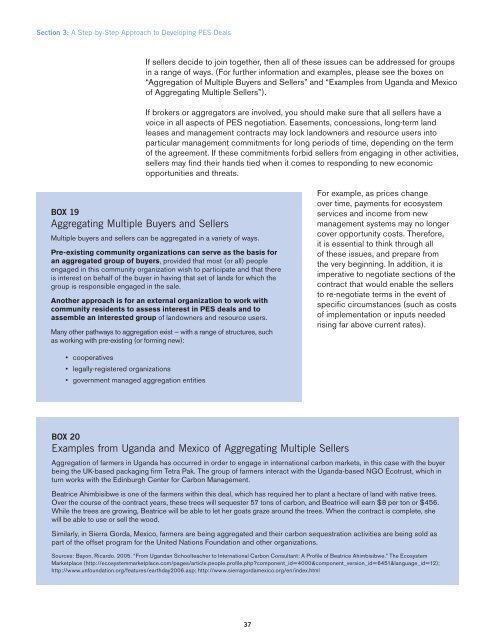Payments for Ecosystem Services: Getting Started. A Primer - UNEP
Payments for Ecosystem Services: Getting Started. A Primer - UNEP
Payments for Ecosystem Services: Getting Started. A Primer - UNEP
You also want an ePaper? Increase the reach of your titles
YUMPU automatically turns print PDFs into web optimized ePapers that Google loves.
Section 3: A Step-by-Step Approach to Developing PES Deals<br />
If sellers decide to join together, then all of these issues can be addressed <strong>for</strong> groups<br />
in a range of ways. (For further in<strong>for</strong>mation and examples, please see the boxes on<br />
“Aggregation of Multiple Buyers and Sellers” and “Examples from Uganda and Mexico<br />
of Aggregating Multiple Sellers”).<br />
If brokers or aggregators are involved, you should make sure that all sellers have a<br />
voice in all aspects of PES negotiation. Easements, concessions, long-term land<br />
leases and management contracts may lock landowners and resource users into<br />
particular management commitments <strong>for</strong> long periods of time, depending on the term<br />
of the agreement. If these commitments <strong>for</strong>bid sellers from engaging in other activities,<br />
sellers may fi nd their hands tied when it comes to responding to new economic<br />
opportunities and threats.<br />
BOX 19<br />
Aggregating Multiple Buyers and Sellers<br />
Multiple buyers and sellers can be aggregated in a variety of ways.<br />
Pre-existing community organizations can serve as the basis <strong>for</strong><br />
an aggregated group of buyers, provided that most (or all) people<br />
engaged in this community organization wish to participate and that there<br />
is interest on behalf of the buyer in having that set of lands <strong>for</strong> which the<br />
group is responsible engaged in the sale.<br />
Another approach is <strong>for</strong> an external organization to work with<br />
community residents to assess interest in PES deals and to<br />
assemble an interested group of landowners and resource users.<br />
Many other pathways to aggregation exist — with a range of structures, such<br />
as working with pre-existing (or <strong>for</strong>ming new):<br />
For example, as prices change<br />
over time, payments <strong>for</strong> ecosystem<br />
services and income from new<br />
management systems may no longer<br />
cover opportunity costs. There<strong>for</strong>e,<br />
it is essential to think through all<br />
of these issues, and prepare from<br />
the very beginning. In addition, it is<br />
imperative to negotiate sections of the<br />
contract that would enable the sellers<br />
to re-negotiate terms in the event of<br />
specifi c circumstances (such as costs<br />
of implementation or inputs needed<br />
rising far above current rates).<br />
• cooperatives<br />
• legally-registered organizations<br />
• government managed aggregation entities<br />
BOX 20<br />
Examples from Uganda and Mexico of Aggregating Multiple Sellers<br />
Aggregation of farmers in Uganda has occurred in order to engage in international carbon markets, in this case with the buyer<br />
being the UK-based packaging fi rm Tetra Pak. The group of farmers interact with the Uganda-based NGO Ecotrust, which in<br />
turn works with the Edinburgh Center <strong>for</strong> Carbon Management.<br />
Beatrice Ahimbisibwe is one of the farmers within this deal, which has required her to plant a hectare of land with native trees.<br />
Over the course of the contract years, these trees will sequester 57 tons of carbon, and Beatrice will earn $8 per ton or $456.<br />
While the trees are growing, Beatrice will be able to let her goats graze around the trees. When the contract is complete, she<br />
will be able to use or sell the wood.<br />
Similarly, in Sierra Gorda, Mexico, farmers are being aggregated and their carbon sequestration activities are being sold as<br />
part of the offset program <strong>for</strong> the United Nations Foundation and other organizations.<br />
Sources: Bayon, Ricardo. 2005. “From Ugandan Schoolteacher to International Carbon Consultant: A Profi le of Beatrice Ahimbisibwe.” The <strong>Ecosystem</strong><br />
Marketplace (http://ecosystemmarketplace.com/pages/article.people.profi le.php?component_id=4000&component_version_id=6451&language_id=12);<br />
http://www.unfoundation.org/features/earthday2006.asp; http://www.sierragordamexico.org/en/index.html<br />
37
















